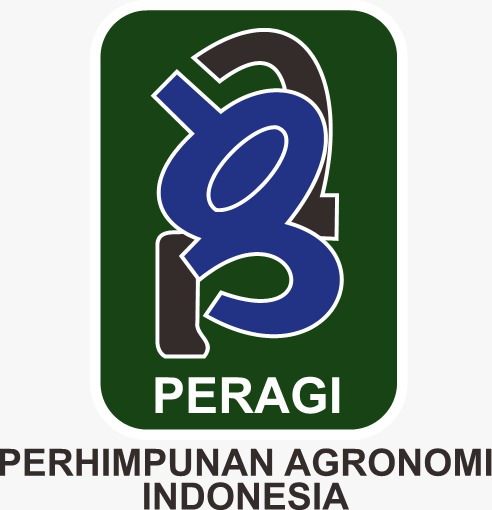The Effectiveness of The Inhibition of Local Bacterial Isolate From The Rhizosphere of Oil Palm Plant on Leaf Spot Disease in Purple Eggplant (Solanum melongena L.)
Abstract
Longterm use of pesticides can cause side effects on the environment and human health. PGPR is an environmentally friendly solution for biological control of leaf spot disease. This research aims to obtain bacterial isolates from the rhizosphere of oil palm plants which have the potential as biological agents to control fungal leaf spot diseases in eggplant plants. The research was carried out using 10 treatments, namely giving 9 samples of different bacterial isolates and 1 control and repeated 2 times, bringing the total to 20 plant samples. The results showed that there were 4 bacterial isolates from the rhizosphere of oil palm plants that had great potential to inhibit the growth of leaf spot fungi, namely isolate R5 (99.35%), isolate R2 (98.1%), isolate R6 (94.69%) and isolate R10 (94.29%). The bacterial isolates that were able to reduce the percentage of disease attacks compared to the first week of observation to the fourth week were isolates R4, R2 and R10, with a reduction in the percentage of disease attacks respectively of 15.15%, 7.14% and 1.98%. Based on the data, it can be seen that the R2 bacterial isolate is an isolate that has the potential to inhibit fungal isolates and reduce the percentage of leaf spot disease attacks on eggplant plants.
Downloads
References
Agrios, G,N. 2005. Plant Pathology 5th eds. Elesevier Academic Press.USA.
Anggraeni, I. 2007.Cercospora sp. Penyebab Penyakit Bercak Daun pada Beberapa Bibit Tanaman Hutan di Persemaian. Mitra Hutan Tanaman. 4 (1).
Deni E. I. 2012. Bakteri Rhizosfer Pemacu Pertumbuhan Plant Growth Promoting Rhizobakteri. Pertanian Sehat Indonesia.
Destia, S., Walida, H., Siti, S. H. Y., Novilda, M. E., & Fitra, H. S. (2021). Analysis of the Quality of Vermicompost from Mixed of Sawdust, Banana Stems, Manure, and Vegetable Waste. Jurnal agronomi tanaman tropika (juatika), 3(2), 128-134.
Glick, B.R., B. Todorovic, J. Czarny, Z.Cheng, J.Duan & B.McConkey. 2007.Promotion of Plant Growth by Bacterial ACC Deaminase. Crit.Rev. Plant.Sci. 26.
Harahap, F. S., Oesman, R., Fadhillah, W., & Rafika, M. (2021). Chemical Characteristics Of Inceptisol Soil With Urea and Goat Manure Fertilizer. Jurnal Agronomi Tanaman Tropika (JUATIKA), 3(2), 117-127.
Harahap, F. S., Walida, H., Rahmaniah, R., Rauf, A., Hasibuan, R., & Nasution, A. P. (2020). Pengaruh aplikasi tandan kosong kelapa sawit dan arang sekam padi terhadap beberapa sifat kimia tanah pada tomat. Agrotechnology Research Journal, 4(1), 1-5.
Jusfah, 2009. Pengaruh Cercospora personata terhadap hasil kacang tanah (Arachis hypogaea). Prosiding Kongres Nasional PF1 VII di Cibubur. Jakarta.
Kishore, G. Krishna., Suresh Pande, and A. R. Podile. 2005. Biologi control of late leaf spot of peanut with chitinolytic bacteria. Phyto pathology 95 (10).
Parman, S. 2009. Pengaruh Pemberian Pupuk Organik Cair Terhadap Pertumbuhan dan Produksi Terung (Solanum melongena L.) Buletin Anatomi dan Fisiologi, 15(2).
Saleh, N. 2010. Optimalisasi Pengendalian Terpadu Penyakit Bercak Daun dan Karat Kacang Tanah. Pengembangan Inovasi Pertanian. 3(4)
Semangun, H. 2004. Penyakit – penyakit Tanaman Pangan di Indonesia. Gadjah Mada University Press: Yogyakarta.
Simatupang, A. 2014. Sayuran Jepang.Penebar Swadaya:Jakarta.
Soesanto L. 2008. Pengantar Pengendalian Hayati Penyakit Tanaman: Suplemen ke Gulma dan Nematoda. Jakarta: PT Raja Grafindo Persada.
Sriyanti. Ni Luh G. 2015. Uji keefektifan rhizobakteri dalam menghambat pertumbuhan jamur Collectricum sp penyebab antraknoksa pada cabai merah. E-Jurnal Agroteknologi Tropika.
Sudarma, I.M. 2011. Epidemiologi Penyakit Tumbuhan : Monitoring, Peramalan dan Strategi Pengendalian (Buku Ajar). Fak. Pertanian UNUD: Denpasar.
Sunarjono, H. A., A. Soetasad dan S. Muryanti, 2003. Budidaya Terung Lokal dan Terung Jepang. Penebar Swadaya: Jakarta.
Surya, E., Hanum, H., Hanum, C., Rauf, A., Hidayat, B., & Harahap, F. S. (2019). Effects of composting on growth and uptake of plant nutrients and soil chemical properties after composting with various comparison of POME. International Journal of Environment, Agriculture and Biotechnology, 5(6).
Sutariati GAK. 2006. Perlakuan Benih Dengan Agens Biokontrol untuk Penyakit Antraknosa, Peningkatan Hasil dan Mutu Benih Cabai. Disertasi. Program Pascasarjana Institut Pertanian Bogor.
Suwahyono. U., dan P. Wahyudi. 2001. Trichoderma harzianumdan Aplikasinya: Penelitian dan Pengembangan Agen Pengendalian Hayati. Direktorat Teknologi. BPPT: Jakarta.
Viveros, OM, M.A. Jorquera, D.E. Crowley, G. Gajardo & M.L. Mora. 2010. Mechanisms and Practical Considerations Involved in Plant Growth Promotion by Rhizobacteria. JSoil Sci Plant Nutr. 10.
Walida, H., Harahap, F. S., & Dalimunthe, B. A. (2019). Isolasi Dan Uji Antagonis Mikroorganisme Lokal (MOL) Rebung Bambu Terhadap Cendawan Fusarium sp. Jurnal Agroplasma, 6(2), 1-6.
Walida, H., Harahap, F. S., Hasibuan, M., and Yanti,F.F.2019.Isolasi dan Identifikasi Bakteri Penghasil IAA dan Pelarut Fosfat dari Rhizosfer Tanaman Kelapa Sawit. BIOLINK 6(1).
Westphal, A., T.S Abney, and G. Shaner. 2009. Deases of soybean (Frogeye Leaf Spot). Botani Plant Pathology.
Copyright (c) 2024 Hilwa Walida, Fitra Syawal Harahap Syawal Harahap, Dewi Apriliawati Siregar

This work is licensed under a Creative Commons Attribution 4.0 International License.
Authors who publish with Jurnal Agronomi Tanaman Tropika (JUATIKA) agree to the following terms:
Authors retain copyright and grant the Jurnal Agronomi Tanaman Tropika (JUATIKA) right of first publication with the work simultaneously licensed under a Creative Commons Attribution License (CC BY 4.0) that allows others to share (copy and redistribute the material in any medium or format) and adapt (remix, transform, and build upon the material for any purpose, even commercially) with an acknowledgment of the work's authorship and initial publication in Jurnal Agronomi Tanaman Tropika (JUATIKA).
Authors are able to enter into separate, additional contractual arrangements for the non-exclusive distribution of the journal's published version of the work (e.g., post it to an institutional repository or publish it in a book), with an acknowledgment of its initial publication in Jurnal Agronomi Tanaman Tropika (JUATIKA). Authors are permitted and encouraged to post their work online (e.g., in institutional repositories or on their website) prior to and during the submission process, as it can lead to productive exchanges, as well as earlier and greater citation of published work.







 More Information
More Information



